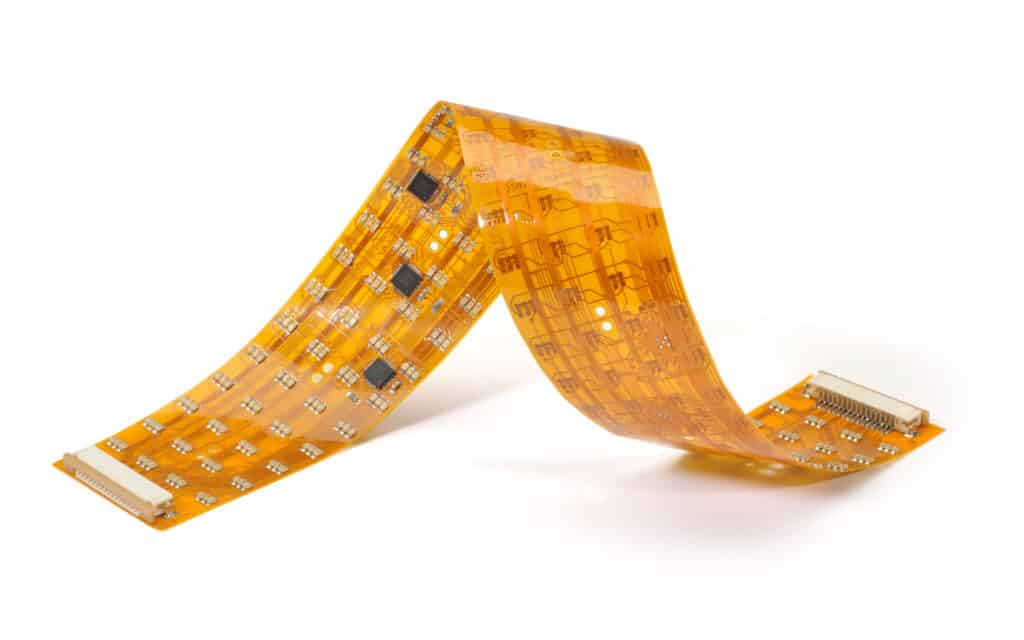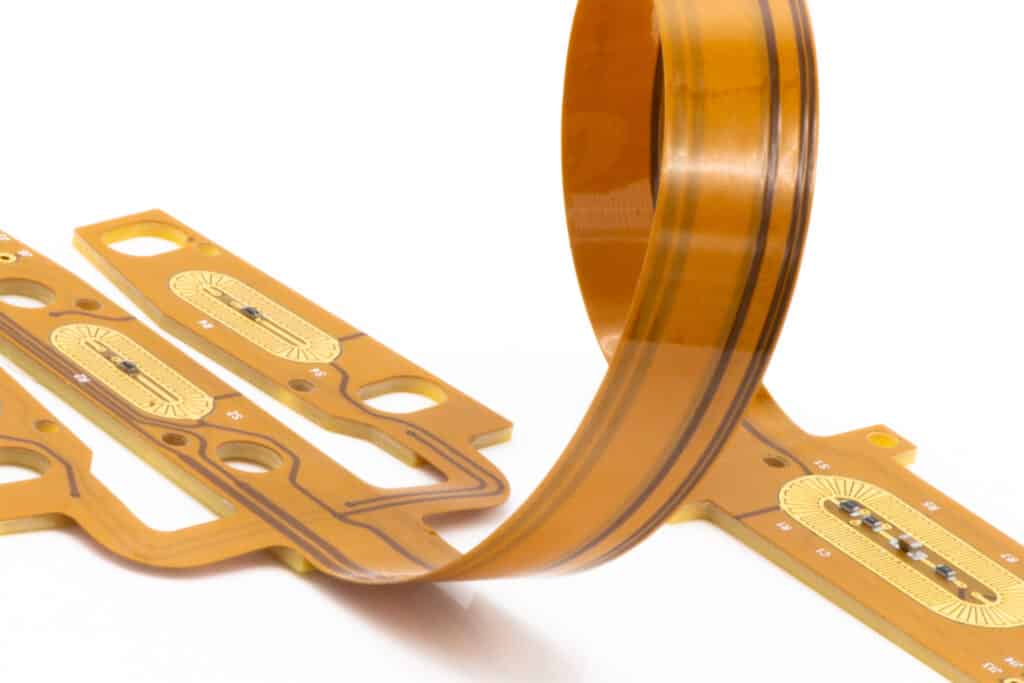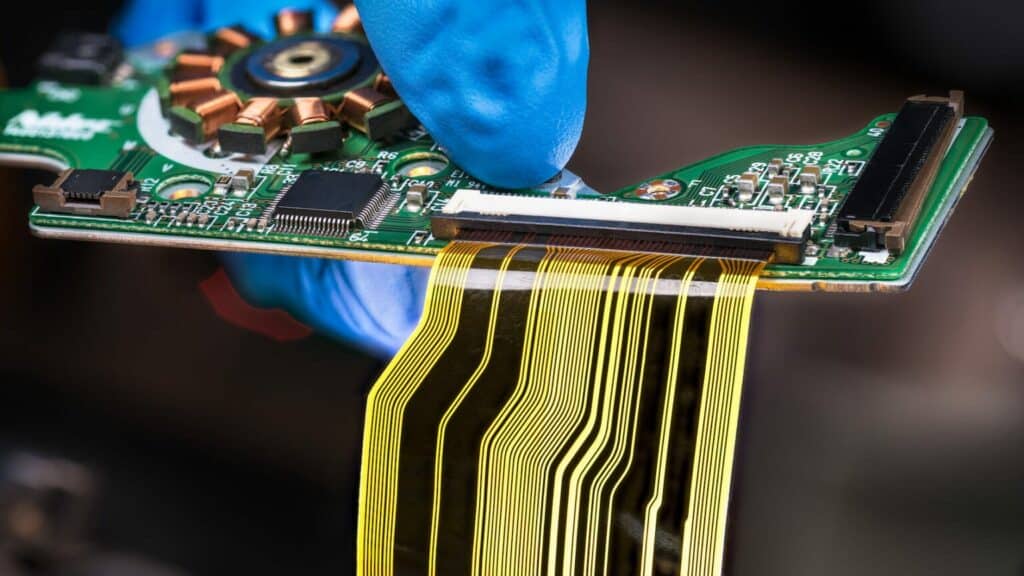Flex circuits are becoming more popular everyday. Their increasing demand is a result of the benefits they offer in a wide range of applications. Modern day electronic devices integrate flex circuits. In today’s world, flexibility has become the cornerstone of most design concepts. The development of consumer electronics like curved PC monitors and curved 4K TVs is a result of the availability of flex circuits.
Flex circuits are available in single-sided, double-sided, and multilayer designs. In this article, our main focus is on multilayer flex PCBs.

What is Multilayer Flex Circuit?
A multilayer flex circuit comprises three or more conductive flexible layers. Each of these layers has flexible insulating layers between them. The manufacturing of multi layer flex circuit involves the combination of double sided or single sided circuits. Furthermore, the manufacturer uses plated through holes to created interconnections among the combined circuits.
Therefore, this makes it very easy to achieve HDIs (high density interconnections). Also, these interconnections are crucial for applications where layers of conductor can’t meet circuit packaging requirements. The three layer flex circuit board is the easiest multilayer flex circuit to fabricate. This circuit is similar to a coaxial wire.
The four layer flex circuit comprises multiple conductive layers. It is the commonly used in the electronics industry. Also, this circuit integrates metalized holes to identify interlayer interconnection. Multi layer flexible circuits are very complex to fabricate. Therefore, they are usually more costly than their counterparts. Also, they are commonly integrated in applications that justify their capabilities and cost. For instance, aerospace and military applications.
The flex layers in this circuit offer a great level of flexibility. Also, these flex layers are crucial for the functioning of some devices. Continuous lamination in this multilayer board can cause problems.
Multilayer Flex Circuit Design
The multilayer flex circuit design comprises four primary elements which are:
Conductors
Multi layer flex circuit comprises several conductor materials like carbon, copper, aluminum, and more. Also, copper is commonly used in the conductors of multilayer circuit boards. These flexible conductive layers are crucial for the functioning of multilayer flexible boards.
Adhesives
For multilayer flex circuits, there are different types of adhesives used. The adhesives can be epoxy, adhesiveless base, or acrylic. Also, adhesiveless materials feature more superior electrical properties.
Insulators
The flexible insulating layers of multilayer flex PCBs are usually between two layers of the PCB. Also, these layers can be made of different materials such as screen printed dielectric, polyimide, and polyethylene terepthalate. However, the commonest insulator material is polyimide.
Finishes
The printed circuit board needs finishing once it is ready. There are various types of finishes for multilayer flex circuits.
Materials used in multilayer flex circuits:
Reinforcing materials are unique in multilayer flexible circuits. These materials are mainly used in some parts of the flex circuit. Also, they improve the strength of these parts of the flexible circuit.
- Cover film
This material consists of three different parts which are PI, release paper, adhesive. Also, the release paper is usually peeled of.
- Substrate
There are two different types of multilayer flex substrate. These are glue-free and glue substrates.
- Auxiliary materials
These include materials such as steel sheet reinforcement materials, pure copper foil, etc.
Benefits of Multilayer Flex Circuits

Multi layer flex circuit offers a lot of benefits. Therefore, they are widely used across several industries. Some of the benefits of these printed circuit boards include:
Enhanced heat dissipation
Multilayer flex circuit features high surface-to-volume ratio. Therefore, this enables the creation of a shorter thermal path. Also, multilayer flex circuit designs are usually slim. Therefore, this enhances heat dissipation via both sides of the printed circuit board.
More compact configuration
The dielectric substrates used for multi layer flex circuits are very thin. Also, these circuits integrate the thinnest dielectric substrates. This extra thinness makes it possible to achieve a more compact configuration, thereby, eliminating the need for rigid boards.
Reduced package size and weight
Due to the reduced package size and weight of multi layer flex circuits, they are meeting the demands in the electronics industry.
Enhanced durability
A multilayer flex circuit is a perfect option for designs that feature moving parts. This is because this circuit can bend million times. Also, polyimide features excellent thermal stability. Therefore, a multilayer flex circuit can withstand extreme temperatures.
Reduced assembly errors and costs
Multilayer flex circuit fabrication doesn’t involve the integration of hand-built wire harness. Therefore, this helps to get rid of human errors. Since multilayer flex circuit assembly doesn’t involve manual labor, there is reduction in production errors. Therefore, this helps to eliminate the cost incurred in correcting errors.
Flexibility
Multilayer flex circuits offer enough flexibility. Also, this circuit design integrates 3rd dimension. Also, it is possible to manipulate multilayer flex circuits in the installation process.
Other benefits include:
- Enhanced signal quality
- Enhanced circuit density
- Better operating temperature range
- Increased reliability and impedance control
- Unparalleled design flexibility
- Improved system reliability
- Better airflow
Drawbacks of Multilayer Flex Circuits
Multilayer flexible circuit has some limitations despite its benefits.
High cost
The fabrication of multilayer flex circuits is a costly and complex process. Also, circuit design and wiring is very costly. Therefore, multilayer flex circuits are rarely used. They are specially designed for applications that require a high level of flexibility and performance.
Low yield rate
As a result of the challenges and difficulties experienced in multi layer flex circuit fabrication, there is high scrap rate of the final PCB. Therefore, the price of multilayer flex keeps increasing.
Restrictions in the size of the final PCB
The size of the production equipment used in multilayer flex circuits limits its size. Also, these circuits can’t be very wide or long.
Circuit damage
Multilayer flex circuits fabrication requires great expertise. This is because improper assembly can lead to circuit damage. Also, improper operation of assemblers can result in damage to the circuit.
Multilayer Flex Circuit Stack Up

Stackup offers you a better circuitry on a board. Also, stack up helps to mitigate the vulnerability of a circuit to external noise and reduces electromagnetic emissions. A multilayer flex circuit will enhance flexibility and pace. A stackup involves the combination of copper and insulating layers.
Multilayer flex circuit stackup comprises at least three conductive layers. Also, the insulation board is the bottom layer and the manufacturer attaches each circuit to the next. The layer stacks will protect the internal layers of the circuit board from any external noise.
Furthermore, PCB stackup helps to add more functionality to a circuit. Also, a multilayer flex circuit stack up helps to make the best decisions for your circuit board. This stack up is specially arranged to meet design requirements. A proper stack up can help to achieve a low cost manufacturing.
Types of multilayer flex stackup
Multilayer flex circuits have two different types of stack up:
Separated stack up
In this type of stackup, the manufacturer separates several layers in the center position. Therefore, the stackup will be unbounded and electronically connected.
Normal stackup
Here, the PCB manufacturer laminates all layers together without separating each layer. Therefore, this type of stackup has no flexibility after lamination. A multilayer flex PCB will be less flexible if it has more layers.
Applications of Multilayer Flex Circuit
There are several use cases of multilayer flex circuit. The flexibility offered by this circuit has made the development of some modern devices possible.
Consumer electronics
There are a wide range of consumer electronics that feature multilayer flex circuits. Examples of such devices include tablet PCs, e-reader, GPS units, and wearable devices among others. Also, you will find these circuits in high performance devices like high-end printers, digital cameras, and desktop computers.
Automotive components
Multilayer flexible circuit is ideal for use in several automotive components. Also, these circuits offer great flexibility and performance in these components. For instance, infotainment systems, automotive engine controls, and HVsAC are examples of automotive components that feature multilayer flexible circuit.
Industrial equipment
Industrial equipment like traffic control equipment, factory automation hardware, and power generation equipment all feature multilayer flex circuits.
Medical devices
In the past few years, wearable devices have become so crucial in the medical industry. The development of multilayer flexible circuits gave way to the development of wearable devices like hearing aid. As medical technology continues to evolve, engineers are also innovating new designs. Multi layer flexible circuit provides more durability and flexibility for these devices.
Aerospace
The aerospace industry also integrates multilayer flex circuits. One of the reasons they are used is the capability of these circuits to withstand extreme temperatures, stress, and vibrations. Furthermore, multilayer flex circuits are widely used in aerospace applications like satellites. Also, these circuits substitute connectors in spacecraft. Connectors are usually more vulnerable to failure.
Military
Most times, military devices are specially designed to withstand extreme temperatures and vibrations. Therefore, multilayer flex boards are suitable for these devices. Also, these circuits have the capability to fit into shapes ideal for military devices.
Conclusion
Multilayer flexible printed circuit boards have become so popular in the electronics industry. They are well known for their distinguishing properties and benefits. Also, these boards play a crucial role in high performance applications like military and aerospace devices. Since these boards are flexible enough for some applications, PCB manufacturers have started offering these circuits as options to electronic manufacturers.

